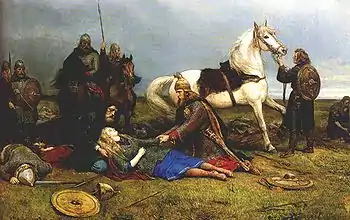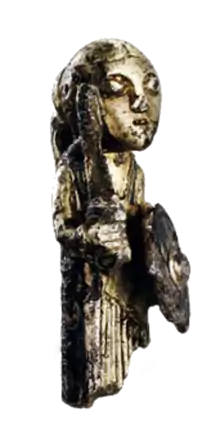Shield-maiden
A shield-maiden (Old Norse: skjaldmær) was a female warrior from Scandinavian folklore and mythology.

Shield-maidens are often mentioned in sagas such as Hervarar saga ok Heiðreks and in Gesta Danorum. They also appear in stories of other Germanic peoples: Goths, Cimbri, and Marcomanni.[1] The mythical Valkyries may have been based on such shield-maidens.[1]
Historical existence
The historical existence of shield-maidens has been debated. The most recent scholarship, including that of archaeologist Neil Price, argues that they existed.[2][3] Some scholars, such as professor Judith Jesch, have cited a lack of evidence for trained or regular woman warriors.[4]
Archaeology
Graves of female settlers containing weapons have been uncovered, but scholars do not agree how these should be interpreted.[5] Norse immigrant graves in England and chemical analysis of the remains suggested a somewhat equal distribution of men and women, suggesting husbands and wives, while some of the women were buried with weapons.[6][7] In a tie-in special to the TV series Vikings, Neil Price showed that a 10th-century Birka-burial excavated in the 1970s containing many weapons and the bones of two horses turned out to be the grave of a woman upon bone analysis by Anna Kjellström.[2] In 2017, DNA analysis confirmed that the person was female,[8] the so-called Birka female Viking warrior, but others, including scholar of the Vikings Judith Jesch, say that conclusion is premature.[9]
Historical accounts
There are few historical attestations that Viking Age women took part in warfare. The Byzantine historian John Skylitzes records that women fought in battle when Sviatoslav I of Kiev attacked the Byzantines in Bulgaria in 971.[10] When the Varangians (not to be confused with the Byzantine Varangian Guard) had suffered a devastating defeat in the Siege of Dorostolon, the victors were stunned to discover armed women among the fallen warriors.[10]
When Leif Erikson's pregnant half-sister Freydís Eiríksdóttir was in Vinland, she is reported to have taken up a sword and, bare-breasted, scared away the attacking Skrælings.[10] The fight is recounted in the Greenland saga, which does not explicitly refer to Freydís as a shield-maiden.[11]
Saxo Grammaticus[12] reported that shield-maidens fought on the side of the Danes at the Battle of Brávellir in the year 750:
Now out of the town of Sle, under the captains Hetha (Heid) and Wisna, with Hakon Cut-cheek came Tummi the Sailmaker. On these captains, who had the bodies of women, nature bestowed the souls of men. Webiorg was also inspired with the same spirit, and was attended by Bo (Bui) Bramason and Brat the Jute, thirsting for war.
Legendary accounts
Examples of shield-maidens mentioned by name in the Norse sagas include Brynhildr in the Vǫlsunga saga, Hervor in Hervarar saga ok Heiðreks, the Brynhildr of the Bósa saga ok Herrauðs, the Swedish princess Thornbjǫrg in Hrólfs saga Gautrekssonar, Princess Hed in Gesta Danorum, Visna in Gesta Danorum and Veborg in Gesta Danorum.
Two shield-maidens appear in certain translations of the Hervarar saga. The first of these Hervors was known to have taken up typically masculine roles early in her childhood and often raided travelers in the woods dressed as a man. Later in her life, she claimed the cursed sword Tyrfing from her father's burial site and became a seafaring raider. She eventually settled and married. Her granddaughter was also named Hervor and commanded forces against attacking Huns. Although the saga remarks on her bravery she is mortally wounded by enemy forces and dies on the battlefield.[13] Scholars Judith Jesch and Jenny Jochens theorize that shield-maidens' often grim fates or their sudden return to typically female roles is a testament to their role as figures of both male and female fantasy as well as emblematic of the danger of abandoning gender roles.[13]
Brynhildr Buðladóttir and Guðrún Gjúkadóttir
%252C_G._Bussiere%252C_1897.jpg.webp)
Brynhildr of the Vǫlsunga saga, along with her rival in love, Guðrún Gjúkadóttir, provides an example of how a shield-maiden compares to more conventional aristocratic womanhood in the sagas. Brynhildr is chiefly concerned with honour, much like a male warrior. When she ends up married to Guðrún's brother Gunnarr instead of Sigurðr, the man she intended to marry, Brynhildr speaks a verse comparing the courage of the two men:[14]
Sigurd fought the dragon
And that afterward will be
Forgotten by no one
While men still live.
Yet your brother
Neither dared
To ride into the fire
Nor to leap across it.
Brynhildr is married to Gunnarr and not Sigurðr because of deceit and trickery, including a potion of forgetfulness given to Sigurðr so he forgets his previous relationship with her.[15] Brynhildr is upset not only for the loss of Sigurðr but also for the dishonesty involved. Similar to her male counterparts, the shield-maiden prefers to do things straightforwardly, without the deception considered stereotypically feminine in much of medieval literature. She enacts her vengeance directly, resulting in the deaths of herself, Sigurðr, and Sigurð's son by Guðrún. By killing the child, she demonstrates an understanding of feud and filial responsibility; if he lived, the boy would grow up to take vengeance on Brynhildr's family.
Guðrún has a similar concern with family ties, but at first does not usually act directly. She is more inclined to incite her male relatives to action than take up arms herself. Guðrún is no shield-maiden, and Brynhildr mocks her for this, saying, "Only ask what is best for you to know. That is suitable for noble women. And it is easy to be satisfied while everything happens according to your desires."[15] In her later marriages, however, she is willing to kill her children, burn down a hall, and send her other sons to avenge the murder of her daughter, Svanhildr. In the world of the sagas, women can be both honorable and remorseless, much like the male heroes. While a shield-maiden does not fill a woman's typical role, her strength of character is found in even the more domestic women in these stories.
In popular culture
Female warriors inspired by the Norse sagas are portrayed in numerous works of historical and fantasy fiction, including prominently in such works as the 2013 TV series Vikings. The show depicts Lagertha (played by Katheryn Winnick) as the greatest shield maiden in the world.
Explaining the inclusion of a female Viking warrior protagonist in the video game Assassin's Creed Valhalla, the game's historical advisor Thierry Noël said, "The archaeological sources are highly debated on that specific issue. But (...) it was part of [the Norse] conception of the world. Sagas and myths from Norse society are full of tough female characters and warriors. It was part of their idea of the world, that women and men are equally formidable in battle".[16]
While women warriors are a staple of fantasy fiction, they are not often referred to as shield-maidens. Some who are include Éowyn in J. R. R. Tolkien's The Lord of the Rings[17] and Thorgil in Nancy Farmer's The Sea of Trolls trilogy.
See also
References
- The article Sköldmö in Nordisk familjebok (1917).
- "Secrets of the Vikings: Shield Maidens". www.history.com. Archived from the original on 25 January 2016.
- Anderson, Christina (14 September 2017). "A Female Viking Warrior? Tomb Study Yields Clues". nytimes.com. Retrieved 24 August 2018.
- Jesch, Judith (19 April 2014). "Viking women, warriors, and valkyries". blog.britishmuseum.org. Archived from the original on 3 March 2016. Retrieved 10 May 2017.
- Foss, Arild S. (2 January 2013). "Don't underestimate Viking women". sciencenordic.com. Archived from the original on 26 March 2017. Retrieved 10 May 2017.
- McLeod, Shane (2011). "Warriors and women: the sex ratio of Norse migrants to eastern England up to 900 AD". Early Medieval Europe. 19 (3): 332–353. doi:10.1111/j.1468-0254.2011.00323.x.
- Vergano, Dan (July 19, 2011). "Invasion of the Viking women unearthed". USA Today.
- Hedenstierna-Jonson, Charlotte; Kjellström, Anna; Zachrisson, Torun; Krzewińska, Maja; Sobrado, Veronica; Price, Neil; Günther, Torsten; Jakobsson, Mattias; Götherström, Anders; Storå, Jan (2017). "A female Viking warrior confirmed by genomics". American Journal of Physical Anthropology. 164 (4): 853–860. doi:10.1002/ajpa.23308. PMC 5724682. PMID 28884802.
- Anderson, Christina (14 September 2017). "A Female Viking Warrior? Tomb Study Yields Clues". The New York Times. Retrieved 24 August 2018.
- Harrison, D. & Svensson, K. (2007). Vikingaliv. Fälth & Hässler, Värnamo. ISBN 978-91-27-35725-9. p. 71
- Thorsson, Ö. (Ed.) The Sagas of the Icelanders. Penguin Books, 1997. Anyway a mention of a single woman picking up a sword once can not be considered evidence of actual trained female warriors.
- Grammaticus, Saxo (2006-02-11) [early years of the 13th Century CE], Killings, Douglas B. (ed.), The Danish History, Books I–IX [The Nine Books of the Danish History of Saxo Grammaticus] (E-book) (in Latin), translated by Elton, Oliver, New York: Norroena Society (published 1905), retrieved 2020-01-02 – via Project Gutenberg
- Tolkien, Christopher. "The Saga of King Heidrik the Wise" (PDF). Thomas Nelson and Sons Ltd. Retrieved April 22, 2013.
- Jesse L. Byock, trans., Saga of the Volsungs (University of California Press, 1990).
- Byock, Jesse L. (Trans.) Saga of the Volsungs.University of California Press, 1990.
- "Assassin's Creed Valhalla – The History Behind the Viking Legend". www.ubisoft.com. Retrieved 2020-05-02.
- Young, Helen (2015). Fantasy and Science Fiction Medievalisms: From Isaac Asimov to A Game of Thrones. Cambria Press. p. 55, note 37. ISBN 978-1-62196-747-7.
The gender-role inversion in Arbo's painting does not last for long: later in the film, Éowyn takes the same position as the shield maiden Hervor in the painting, lying on a field strewn with dead bodies, where her brother, Éomer, finds her. The colors in Arbo's painting are the golds, reds, yellows, and blues found in Rohan in the film, down to the white of the steed that, in the painting, has survived its rider.
External links
| Wikimedia Commons has media related to Shieldmaidens. |
